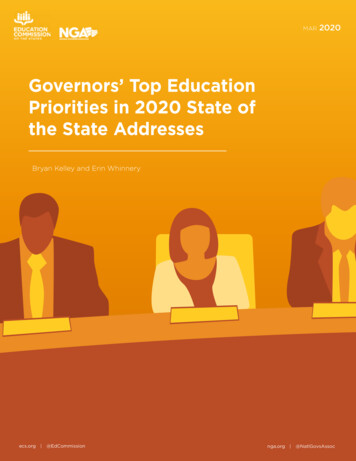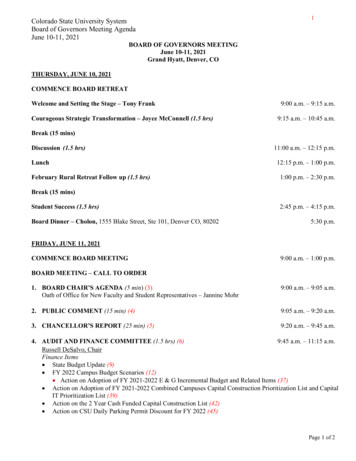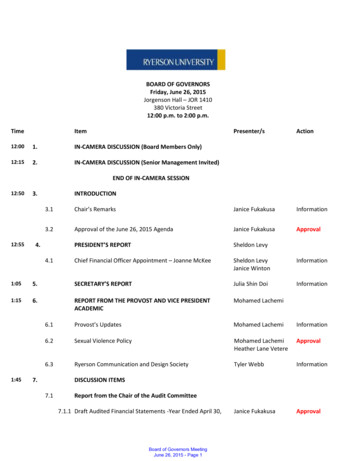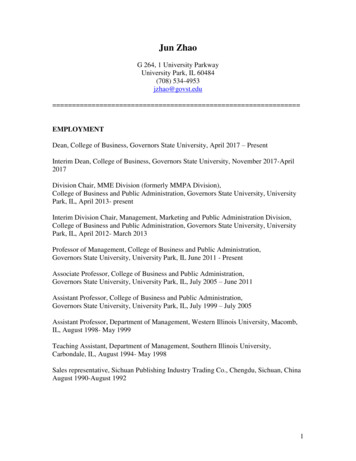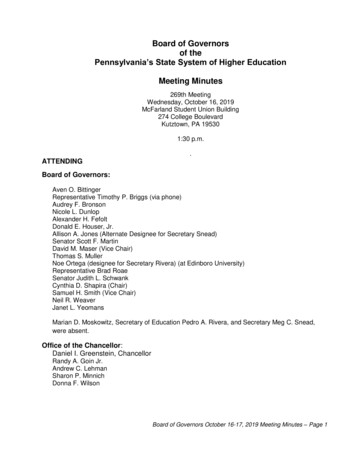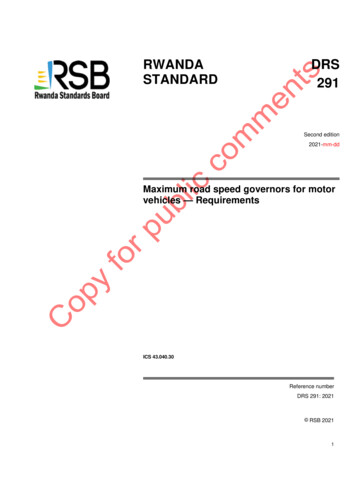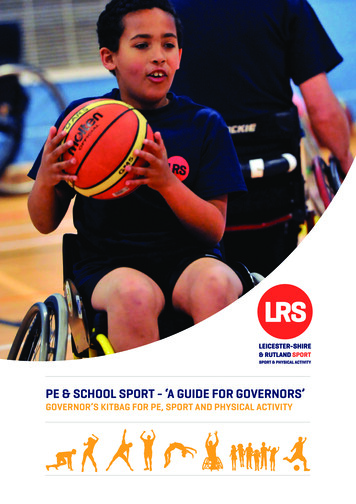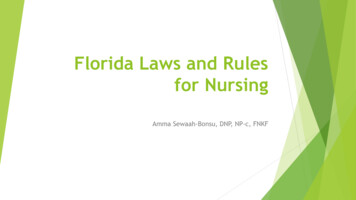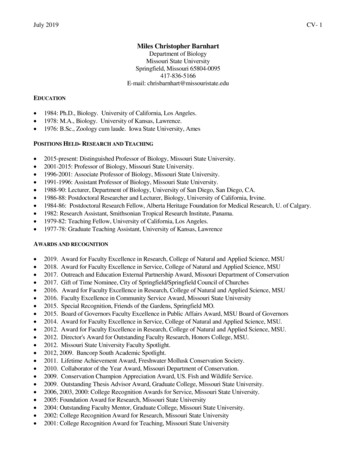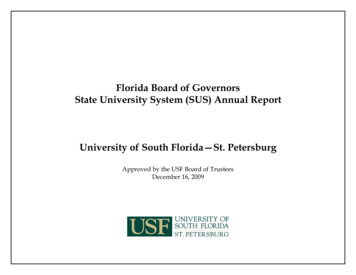
Transcription
Florida Board of GovernorsState University System (SUS) Annual ReportUniversity of South Florida—St. PetersburgApproved by the USF Board of TrusteesDecember 16, 2009
Data DefinitionsGOAL 1:· Baccalaureate Degrees Awarded and Graduate Degrees Awarded: Graduatedegrees include master’s, research doctoral, and professional doctoral programs.Source: SUS Student Instruction File· # and % Baccalaureate Degrees Awarded (Non-Hispanic Blacks and Hispanics):The number of baccalaureate degrees granted to non-Hispanic black students orHispanic students. The percentage is the number of baccalaureate degrees awarded toeach group divided by the total number of degrees awarded, excluding those awardedto non-resident aliens and those not reporting race/ethnicity. Source: SUS StudentInstruction File· # and % Baccalaureate Degrees Awarded (Pell Recipients): The number ofbaccalaureate degrees awarded to federal Pell grant recipients, an indicator of lowfamily income. For this report, a Pell grant recipient is defined as a student whoreceived Pell within six years of graduation. The percentage is the number ofbaccalaureate degrees awarded to Pell recipients as listed above divided by the totalnumber of degrees awarded, excluding those awarded to non-resident aliens. Sources:SUS Student Instruction File and Student Financial Aid FileGOAL 2:· # Degrees Awarded in Select Areas of Strategic Emphasis: Degrees as reportedabove by six-digit Classification of Instruction Program. The areas of strategicemphasis were selected by the Board of Governors staff in consultation with businessand industry groups.· Pass Rates on Professional Licensure Examinations: Many professional licensuredata, gathered by the respective licensing boards and housed within the Department ofBusiness and Professional Regulation, are not currently formatted and do not containsufficient information to match to SUS data. Board of Governors staff will work withindividuals from the appropriate agencies to try to get data in the needed format.GOAL 3:· Federally Financed and Total Academic Research and Development Expenditures:The National Science Foundation conducts an annual survey of colleges anduniversities regarding research and development expenditures. These amountscombine reported science and engineering R&D expenditures with reported nonscience and engineering expenditures. Dollars are in nominal dollars (i.e., not inflationadjusted). Source: http://webcaspar.nsf.gov/
· # Licenses/Options Executed: Count of the number of licenses/options executed inthe fiscal year for all technologies. Each license agreement is counted separately.Source: AUTM Licensing Survey· Licensing Income Received: License issue fees, payments under options, annualminimums, running royalties, termination payments, amount of equity received whencashed-in, and software and biological material end-user license fees of 1,000 or more,but not research funding, patent expense reimbursement, valuation of equity notcashed-in, software and biological material end-user license fees of less than 1,000, ortrademark licensing royalties from university insignia. Source: AUTM LicensingSurveyRESOURCES, EFFICIENCIES, AND EFFECTIVENESS· 6 -Year Graduation and Retention Rates (FTICs), 4-Year Graduation and RetentionRates (AA Transfers), 5-Year Graduation and Retention Rates (Other Transfers): AnFTIC cohort is defined as undergraduates entering in fall term or summer continuingto fall with fewer than 12 hours earned since high school graduation. An AA Transfercohort is defined as undergraduates entering in fall term or summer continuing to falland having earned an AA degree from an institution in the Florida College System. AnOther Transfer cohort is defined as undergraduates entering in fall term or summercontinuing to fall who are not FTICs or AA transfers. The rate is the percentage of theinitial cohort that had either graduated from or was still enrolled in the sixth academicyear for FTIC students, fourth year for AA Transfers, and fifth year for Other Transfers.Both full-time and part-time students are included in the calculation. Source: SUSRetention File· Student-Faculty Ratio: The ratio of full-time equivalent students (full-time plus 1/3part time) to full-time equivalent instructional faculty (full time plus 1/3 part time). Inthe ratio calculations, exclude both faculty and students in stand-alone graduate orprofessional programs such as medicine, law, veterinary, dentistry, social work,business, or public health in which faculty teach virtually only graduate-level students.This metric does not count undergraduate or graduate student teaching assistants asfaculty. Source: Common Data Set/IPEDS· Funding per FTE Student: E&G appropriation and tuition revenues are divided bytotal student FTE. Only state-fundable credit hours are used. To allow for nationalcomparisons, FTE for this metric uses the standard IPEDS definition of FTE, equal to 30credit hours for undergraduates and 24 for graduates. Sources: Operating Budget, SUSStudent Instruction File[Additional definition information in appendices.]
The University of South Florida - St. Petersburg Campus 2009 Annual ReportSites and CampusesEnrollmentsTOTAL(Fall 2008)#%3,771--Degree Programs Offered (2007-08)TOTAL32Carnegie ClassificationUndergraduateInstructional er’s & Specialist’s9Graduate InstructionalProgram:White2,96879%Research Doctorates0Enrollment Profile:Other2326%Professional Doctorates0Undergraduate duate3,136GraduateUnclassifiedFaculty (Fall 2008)FullTimePart-Time83%TOTAL113944712%Tenure/T. Track8711885%Non-Ten. Track268Carnegie Classification not available forcampuses at this time.Size and Setting:Basic:Elective Classification:BOARD OF GOVERNORS – STATE UNIVERSITY SYSTEM GOAL 1:ACCESS TO AND PRODUCTION OF DEGREESGraduate Degrees AwardedBaccalaureate r's6552004-052008-092004-05Research 8-09Black2004-05Hispanic2008-09PellBOARD OF GOVERNORS – STATE UNIVERSITY SYSTEM GOAL 2:MEETING STATEWIDE PROFESSIONAL AND WORKFORCE Baccalaureate by Group as Percentageof Total USF Baccalaureates*Baccalaureate Degrees Awarded byGroup2004-052008-09Excluding Non-Resident Aliens (NRA) &Unreported for Race/Ethnicity & NRA forPell ComparisonsBlackHispanicPell
Graduate DegreesAwarded in Select Areas of StrategicStrategicEmphasisBaccalaureate DegreesAwarded in Select Areas ofStrategic Emphasis100.0%504580.0%604050353060.0%40Pass Rate3025302015201015502008-09Health Professions40.0%20.0%100STEM54Licensure Nursing Programdata is pertinent only to Tampa Campus2008-09EducationEducationHealth Professions0.0%STEMExample for Demonstration Only.BOARD OF GOVERNORS – STATE UNIVERSITY SYSTEM GOAL 3:BUILDING WORLD-CLASS ACADEMIC PROGRAMS AND RESEARCH CAPACITY 4,000,000 3,000,000 2,500,000 2,000,000Development and Research is a USFsystem-wide function and consolidatedsystem data is only available at this time. 1,500,000 1,000,000 500,000 0Federal Only2003-04Licensing Income 3,500,000Millions 1,000,000 900,000 800,000 700,000 600,000 500,000 400,000 300,000 200,000 100,000 054Data is Pertinent Only To Main CampusCampus21Total - All SourcesLicensing Income2007-0843Licenses & Options ExecutedExecutedLicenses & Options ExecutedUniversity Innovations Generating RevenueThrough Technology Transfer:Licenses and Licensing RevenueAcademic Research and DevelopmentExpendituresMillions
Key University Achievements [Include a maximum of three in each category.] Student awards/achievementsThe USFSP Debate team was established in 2008 and placed 8th out of 48teams in its first competition and it continues it winning ways.The USFSP Chapter of Beta Alpha Psi (accounting) Honor Society receivedthe designation of “superior” from the national organization.Dr. Faculty awards/achievementsGerald Lander, the Gregory, Sharer & Stuart P.A., Professor in ForensicAccounting, was named the 2008-2009 Outstanding Accounting Educator inFlorida by the FICPA. Dr. Lander was recognized at a meeting of the Boardof Governors in Tallahassee. Program awards/achievements TheCollege of Business was ranked #36 in the world in the Global 100 ranking of theAspen Institute’s “Beyond Gray Pinstripes” which is based on the strength of aninstitution’s programs in corporate and social responsibility. The College of Education underwent its first site visit for continuing programapproval by the Florida Department of Education in 2008 and received “FullApproval” for its MA in Elementary Education/ESOL. The program’s readingcompetency matrix was deemed a model for the state by the Office of Just Read!Florida. Research awards/achievementsDr.Lyman Dukes launched Project 10: Transition Education Network, a 1.02million dollar annual project funded by the Florida Department of Education toincrease access to higher education for persons with disabilities throughoutFlorida. Institutional awards/achievementsCompleted construction and began operations in the Science and TechnologyBuilding.Completed the Harborwalk at USFSP (a new campus entrance).BOARD OF GOVERNORS – STATE UNIVERSITY SYSTEM GOAL 4:MEETING COMMUNITY NEEDS AND FULFILLING UNIQUE INSTITUTIONAL RESPONSIBILITIES[AVAILABLE FOR DISPLAY OF INSTITUTIONAL PERFORMANCE ON MEASURES RELATED TOMEETING COMMUNITY NEEDS AND FULFILLING UNIQUE INSTITUTIONAL RESPONSIBILITIES]5
RESOURCES, EFFICIENCIES, AND EFFECTIVENESSStudent-to-Faculty RatioUndergraduate Retention andGraduation Rates504540353025201510506-Yr Rates for FTICFTICs 2002-2008Only system data areavailable at this time.FTICs1999-20054-Yr Rates for AA -to-Faculty RatioAATs 2004-2008Only system data areavailable at this time.n 1,914Funding Per Student FTE**AATs 2001--2005 18,000 16,000 14,0005-Yr Rates for Other* 12,000 10,000Others 2003-2008 8,000Only system data areavailable at this time.timeOthers 2000-2005 6,000 4,000 2,000 07-082008-092009-10General Revenue Per FTELottery Funds Per FTEGraduated from USFGraduated from Other SUS InstitutionStudent Fees Per FTEOther Trust Funds Per FTEStill Enrolled at USFStill Enrolled in Other SUS InstitutionTotal Per FTE* The composition of "Other Transfer" cohorts may vary greatly by institution.** FTE for this metric uses the standard IPEDS definition of FTE, equal to 30credit hours for undergraduates and 24 for graduates.6
BOARD OF GOVERNORS – STATE UNIVERSITY SYSTEMGOAL 1: ACCESS TO AND PRODUCTION OF DEGREESIntroductionMissionThe University of South Florida St. Petersburg offers distinctivegraduate and undergraduate programs in the arts and sciences,business, and education within a close knit, student-centered learningcommunity that welcomes individuals from the region, state, nation,and world. We conduct wide-ranging, collaborative research to meetsociety's needs and engage in service projects and partnerships toenhance the university and community's social, economic andintellectual life. As an integral and complementary part of a multiinstitutional system, USF St. Petersburg retains a separate identityand mission while contributing to and benefiting from theassociations, cooperation, and shared resources of a premier nationalresearch university. USF St. Petersburg’s enrollments have been steadily growing over thepast three years, from a total of 3,371 home campus/5,003 fundingcampus (headcount) students in Fall 2006 to 3,771 home campus/5640funding campus (headcount) students in Fall 2008. The suite ofdegree program offerings, both at the undergraduate and graduatelevel have been selected and refined to reflect regional needs and tocomplement those at other USF system member institutions. USFSPoffers a robust academic environment for transfer students althoughthe growth of the state college system has been a challenge torecruitment for this group of students.Overall degree production has remained steady from 06-07 to 08-09with 635 baccalaureate degrees awarded in AY2006-2007 and 653awarded in AY 2008-2009; and 143 graduate degrees awarded inAY2008-09 and 152 graduate degrees awarded in ing VisionThe University of South Florida St. Petersburg will be a premiermaster’s urban university recognized for its vibrant community ofscholars who engage and improve its community and the world.The demographic profile of USFSP students reflects the population ofthe region. USFSP’s academic environment benefits students from alldemographic groups due to its relatively small classes and thecommitment of faculty and staff to student success and to providingstudents with outstanding service in all ther Contextual Introductory CommentsThe University of South Florida St. Petersburg (USFSP) was firstaccredited as a separate institution in 2006. It is now and willcontinue to be a member of the University of South Florida system ofinstitutions which include USF Tampa, USF Sarasota/Manatee (nowseeking separate accreditation) and USF Polytechnic (will seekseparate accreditation in 2010). Over the past three years, USFSP hasstrengthened both its academic and its research profile. The openingof a residence hall for students in fall 2006 represented a milestone inthe realization of the institution’s Strategic Plan. Since 2006 there hasbeen a rapid growth in FTIC enrollment and a concomitant rapidincrease in student organizations, on-campus student life activities,and student support services. USFSP is on a path to realize its visionas a Masters comprehensive university serving regional needs yetreaching nationally and globally in support of the USF system goals. 2
BOARD OF GOVERNORS – STATE UNIVERSITY SYSTEMGOAL 2: MEETING STATEWIDE PROFESSIONAL ANDWORKFORCE NEEDSBOARD OF GOVERNORS – STATE UNIVERSITY SYSTEMGOAL 3: BUILDING WORLD-CLASS ACADEMIC PROGRAMSAND RESEARCH CAPACITYUSF St. Petersburg is focused on meeting both regional and statewideprofessional and workforce needs. It accomplishes this goal byoffering degree programs that address high-need areas withinFlorida’s workforce. For example, the College of Education revisedand refined its undergraduate degree offerings specifically inresponse to the need of local school districts for elementary schoolteachers who are qualified to teach every child, including childrenwith exceptional needs and children whose first language is notEnglish. The new B.S. degree (initiated in 2009) will enable graduatesto be highly flexible in their employment. It will also give principalsand superintendents high confidence that USFSP graduates are wellequipped for success in many educational settings.USFSP has built and is building outstanding academic programs andis expanding research capacity in keeping with its mission.For example: The College of Business received accreditation in both businessand accounting programs from AACSB International. AACSBInternational accreditation has been awarded to only 570institutions which represent less than 10 percent of eligibleinstitutions worldwide. Of these, only 171 institutions haveachieved accreditation in both business and accounting. The College of Business was ranked #36 in the world in the Global100 ranking of the Aspen Institute’s “Beyond Gray Pinstripes”which is based on the strength of an institution’s programs incorporate and social responsibility. The College of Education was approved for candidacy by theNational Council of Teacher Accreditation (NCATE) in 2006. The College of Education underwent its first site visit forcontinuing program approval by the Florida Department ofEducation in 2008 and received “Full Approval” for its MA inElementary Education/ESOL. The program’s reading competencymatrix was deemed a model for the state by the Office of JustRead! Florida. The College of Education received “Full Approval” by the FloridaDepartment of Education in 2008 for all programs leading to statelicensure. The Department of Journalism and Media Studies (College of Artsand Sciences) achieved accreditation through the AccreditingCouncil on Education in Journalism and Mass Communication in2003, one of only 114 such accredited programs in the US. The institution developed a distinctive undergraduate minor inleadership studies that encompasses both curricular and cocurricular elements and now includes a residential learningcommunity and which has been noted by leading nationalscholars of leadership as “teaching the new leadership in the newway.”The Graphic Design program, approved by the BOG as a limitedaccess program, instills in graduates both the intellectual foundationsand the practical skills for success in “new media” as the media andgraphic design industries around the region, the state and the nationmove further, and often exclusively, into the electronic realm. USFSPgraduates are in demand since this program is highly competitive andonly a small number of exceptional students proceed to completion.The program has strong synergy with the Journalism and MediaStudies degree programs (both baccalaureate and masters) and anumber of courses allow students from both programs to enroll.The College of Business offers a unique milieu in which businesseducation is placed. The College has a special focus on corporate andsocial responsibility, that is, the ethical and responsible conduct ofbusiness. The College has been consistently ranked in the top 50institutions in the nation for its achievements in this area. USFSPgraduates in both business and accounting are sought after by Floridafirms since this ethos or corporate and social responsibility is highlyvalued and few institutions make it a focus of their programs.2
BOARD OF GOVERNORS – STATE UNIVERSITY SYSTEMGOAL 3: BUILDING WORLD-CLASS ACADEMIC PROGRAMSAND RESEARCH CAPACITY (Continued) Health and Development (NICHD). One project, alignedwith the Hillsborough County Sheriff Department and theUSF Florida Kinship Center, is designed to promote healthyco-parenting skills among incarcerated mothers and othercaregivers. In a second project the FSC currently partnerswith both Pinellas County Health Department and Mt. ZionHuman Services Center to perform prenatal interventionswith first-time African-American mothers to promote betterpost-natal co-parenting.The College of Education developed a new, uniqueundergraduate degree, the B.S. in Education that provides thesuccessful student with licensure in elementary education andexceptional student education as well as state-approvedendorsements in reading and ESOL.USFSP has greatly expanded and strengthened its focus onundergraduate research with faculty. Undergraduate research hasbeen shown to be a key element in placing students in premiergraduate programs and it has also been shown to improve bothstudent academic performance and persistence.Many USFSP faculty are recognized around the nation and theworld as leading scholars in their fields. For example:o Dr. Ray Arsenault has been recognized for his work on thecivil rights movement.o Dr. Gary Mormino is a leading scholar on modern Floridahistoryo Dr. Sheramy Bundrick has been able to move seamlesslybetween her work as an art historian and creative writing ofhistorical fiction.o Dr. Lyman Dukes is the national authority on standard foraccess to higher education and school-to-work transitionsfor person with disabilities.o Dr. Malcolm Butler is a nationally-recognized scholar inscience education and science teacher education,particularly his work with the National Science Foundationto increase African Americans in the field.o Dr. Mark Durand is a highly regarded scholar in the field ofautism and a prolific textbook authoro Dr. John Arthur is a nationally-known scholar inanthropology with support from the National ScienceFoundation for his work in Ethiopiao Dr. Jamie McHale, Professor of Psychology and founder ofthe USFSP Family Studies Center engages in multipleresearch projects funded by the National Institute of Child3
BOARD OF GOVERNORS – STATE UNIVERSITY SYSTEMGOAL 4: MEETING COMMUNITY NEEDS AND FULFILLINGUNIQUE INSTITUTIONAL RESPONSIBILITIES The University of South Florida St. Petersburg reflects its commitment tomeeting community needs and fulfilling unique institutionalresponsibilities in its mission statement and strategic goals. As an example of this commitment in action, USFSP’s Center forCivic Engagement (CCE) was founded in 2006. The CCE hascatalyzed and funded curricular innovations that focus on civicscholarship and has itself been responsible for contributing nearly238,000 hours to local and regional community organizations with anestimated value of more than 4.5 million since its founding. In June of 2009, the College of Education, SRI International, and thePinellas County Schools began a unique collaborative designed togive the Pinellas schools the capacity to integrate a digital mathcurriculum and teacher professional development into a coherentand effective approach to algebra and geometry instruction. “Givenour strong partnership with the district, the opportunity to combineSRI’s innovative digital math curriculum and the college’s expertisein math education created the ideal combination for achieving ourshared goal of sustainable change,” Dean Vivian Fueyo, College ofEducation. (See the press release for more SunbayDigitalMath.pdf College of Education faculty continue to produce nationally andinternationally recognized research and scholarship in scienceeducation, math education, English for Speakers of Other Languages(ESOL), and educating persons with disabilities. Highlights of USFSPCollege of Education faculty accomplishments in 2009 include: 1) inscience education, Dr. Malcolm Butler, served as the sole scienceeducator on a four- member team that produced NationalGeographic’s first science literacy curriculum; 2) in math education,Dr. Andy Reeves published Cartoon Corner: Mathematics Teaching inthe Middle School for the National Council for Teachers ofMathematics; 3) in ESOL, Dr. Alejandro Brice, published LanguageDevelopment: Monolingual and Bilingual Acquisition for Allyn & Bacon,a major national publisher; and in special education, Dr. LymanDukes launched Project 10: Transition Education Network, a 1.02million dollar annual project funded by the Florida Department of 4Education to increase access to higher education for persons withdisabilities throughout Florida.Dr. Trey Conner, Assistant Professor of Writing, collaborated withMt. Zion Human Services, a local non-profit organization, to createnew uses for old computers. The Center, which serves residents in anarea challenged by poverty and crime in Pinellas County, had a fleetof computers that could no longer run mainstream software. Facedwith few options and no budget, this project provided Mt. Zion afterschool programs with much needed education computinginfrastructure essentially for free using open source software. Opensource technology has a much lower cost because it bears nolicensing fees for programs. The technology network moves awayfrom the personal desktop computer model and relies upon centralservers with client machines.Dr. John Arthur, Associate Professor of Anthropology, receivedpermission from the Weedon Island Cultural and Natural HistoryCenter, Progress Energy, and the State of Florida HistoricalPreservation Office, to start the first systematic excavation of artifactsat Weedon Island. Dr. Arthur and his students from USFSP havebegun to research and document cultural and environmental changesof this land, once inhabited by Native Americans.Dr. Michiko Otsuki, Assistant Professor of Psychology, worked withthe Suncoast Pediatric Asthma Coalition, to co-sponsor “AsthmaFamily Day” at USFSP. This interactive event is designed to improveasthma self-management skills and awareness for children withasthma and their families and strengthen the partnership between themedical community, families and schools working with children whohave asthma.The College of Education and the College of Arts and Sciences atUSFSP have joined forces to increase the number of qualified middleand high school teachers. Approved by the Florida Department ofEducation, this joint Professional Training Option (PTO) offers liberalarts students from selected majors the opportunity to supplementtheir curriculum with 12 credit hours from the College of Educationand a teaching practicum within the Pinellas County School District.The program prepares students for the Florida Teacher Certificationexam.
Additional ResourcesAdditional Information on Quality, Resources, Efficiencies, andEffectiveness[For example, university links should be included for the following]The University of South Florida St. Petersburg has been challenged asnever before by the statewide budget and economic crisis. Thischallenge has resulted in actions to re-engineer many of its processesand reorganize its administrative functions to increase efficiency anddeliver outstanding student services with reduced resources. Forexample, Academic Affairs and Student Affairs realigned admissions,financial aid, registration and records, and student academic support(tutoring center) functions to enable better service to more studentswith fewer people. University Institutional Research Unitwww.stpete.usf.edu/irSection 9 of Annual Report: Progress on Other Primary InstitutionalGoals and Metrics as Outlined in the University Work PlanThe University of South Florida St. Petersburg’s Strategic Plan for2009-2013 includes six over-arching goals, each of which includes subgoals. Each sub-goal includes 1-, 3- and 5-year strategic objectiveswhich have been structured to recognize budget realities while stilladvancing the overall mission of the institution. At this time, workgroups have been established to address Year-1 strategic objectives inall six goals areas of the mission. Goals, sub-goals and strategicobjectives are detailed below.In addition, over the past three years, the institution has alsocontinued to respond to the concerns of the Southern Association ofColleges and Schools. Earlier in 2009, the institution successfullycleared all outstanding issues and is now proceeding on the usual andcustomary path to reaffirmation of accreditation. The institution wasalso successful in achieving separate accreditation for both itsbusiness and accounting programs from the Association to AdvanceCollegiate Schools of Business International (AACSB International), adesignation achieved by only 10 percent of business schoolsworldwide. In addition, the institution underwent a successful visitand review by the Florida Department of Education for all programsleading to state licensure and had a successful visit by a team from theNational Council for the Accreditation of Teacher Education(NCATE) which we are confident will result in full accreditation inSpring 2010.1 – Academic Performance: Support and enhance programs thatprepare students to be knowledgeable, reflective and engaged citizenscholars1.1 Use sustained evidence of student learning outcomes and studentachievement for continuous improvementRefine and continue the integrated academic assessment plan[Year 1]Evaluate the student learning assessment tracking tools that are inplace for monitoring institutional effectiveness [Year 3]Evaluate the integrated assessment plan for efficacy and continueto refine curricula [Year 5]1.2 Offer certificate, undergraduate, and graduate programs that meetregional needsDevelop a needs assessment based on student and communityneeds [Year 1]Utilize data to review and refine existing undergraduate andgraduate curricula and initiate new programs [Year 3]5
Section 9 of Annual Report: Progress on Other Primary InstitutionalGoals and Metrics as Outlined in the University Work Plan(continued)2 – Student Engagement: Enhance learning and achievement andpromote retention through active engagement in curricular and cocurricular programsEvaluate new configuration of curricula and programs [Year 5]1.3 Implement and support information and instructionaltechnologies that facilitate effective pedagogiesDevelop policies and a plan for appropriate delivery andownership of instruction; and create a campus-wide information anddata literacy plan [Year 1]Continue to provide faculty with the knowledge, training, andskills needed to enhance and develop appropriate instructionaldelivery and document continuous improvement in quality [Year 3]Engage in monitoring appropriate deliveries and assess theinformation and data literacy plan and document how the processwill be improved [Year 5]1.4 Enhance programs that specifically support academic excellence.Develop an integrated plan for academic excellence, that caninvolve all students, including the Honors Program, expandedopportunities for undergraduate research and workshops onacademic excellence [Year 1]Expand faculty participation in academic program activities [Year3]Expand student participation in academic program activities[Year 5]1.5 Increase student awareness of participating in a global societyIdentify existing curricular and programmatic content with globalperspectives [Year 1]Assess viability of central support of study abroad programs[Year 3]Support study abroad programs [Year 5]2.1 Create a freshman experience that enables students to thrive andmove successfully through to graduationDevelop an implementation plan for appropriate first yearprogram curricula based on a review of best practices, benchmarkcriteria, and outcome data from other institutions [Year 1]Implement the First Year Experience program [Year 3]Evaluate the efficacy of the Firs
E&G appropriation and tuition revenues are divided by total student FTE. Only state-fundable credit hours are used. To allow for national comparisons, FTE for this metric uses the standard IPEDS definition of FTE, equal to 30 credit hours for undergraduates and 24 for graduates. Sources: Operating Budget, SUS Student Instruction File [[Additional definition infoAdditional definition .

